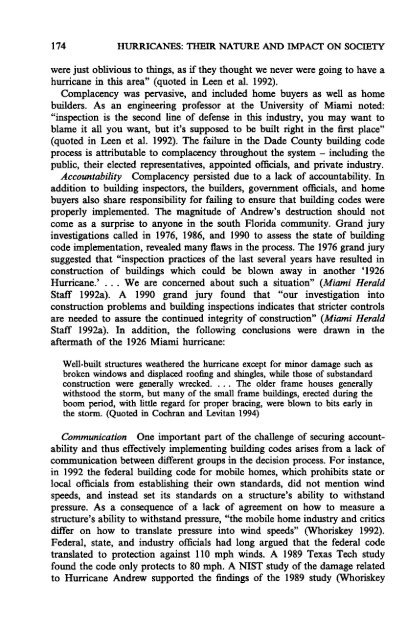Hurricanes: Their Nature and Impacts on Society - Climate Science ...
Hurricanes: Their Nature and Impacts on Society - Climate Science ...
Hurricanes: Their Nature and Impacts on Society - Climate Science ...
You also want an ePaper? Increase the reach of your titles
YUMPU automatically turns print PDFs into web optimized ePapers that Google loves.
174 HURRICANES: THEIR NATURE AND IMPACT ON SOCffiTY<br />
were just oblivious to things, as if they thought we never were going to have a<br />
hurricane in this area" (quoted in Leen et a1. 1992).<br />
Complacency was pervasive, <str<strong>on</strong>g>and</str<strong>on</strong>g> included home buyers as well as home<br />
builders. As an engineering professor at the University of Miami noted:<br />
"inspecti<strong>on</strong> is the sec<strong>on</strong>d line of defense in this industry, you may want to<br />
blame it all you want, but it's supposed to be built right in the first place"<br />
(quoted in Leen et at. 1992). The failure in the Dade County building code<br />
process is attributable to complacency throughout the system -including the<br />
public, their elected representatives, appointed officials, <str<strong>on</strong>g>and</str<strong>on</strong>g> private industry.<br />
Accountability Complacency persisted due to a lack of accountability. In<br />
additi<strong>on</strong> to building inspectors, the builders, government officials, <str<strong>on</strong>g>and</str<strong>on</strong>g> home<br />
buyers also share resp<strong>on</strong>sibility for failing to ensure that building codes were<br />
properly implemented. The magnitude of Andrew's destructi<strong>on</strong> should not<br />
come as a surprise to any<strong>on</strong>e in the south Florida community. Gr<str<strong>on</strong>g>and</str<strong>on</strong>g> jury<br />
investigati<strong>on</strong>s called in 1976, 1986, <str<strong>on</strong>g>and</str<strong>on</strong>g> 1990 to assess the state of building<br />
code implementati<strong>on</strong>, revealed many flaws in the process. The 1976 gr<str<strong>on</strong>g>and</str<strong>on</strong>g> jury<br />
suggested that "inspecti<strong>on</strong> practices of the last several years have resulted in<br />
c<strong>on</strong>structi<strong>on</strong> of buildings which could be blown away in another '1926<br />
Hurricane.' ...We are c<strong>on</strong>cerned about such a situati<strong>on</strong>" (Miami Herald<br />
Staff 1992a). A 1990 gr<str<strong>on</strong>g>and</str<strong>on</strong>g> jury found that "our investigati<strong>on</strong> into<br />
c<strong>on</strong>structi<strong>on</strong> problems <str<strong>on</strong>g>and</str<strong>on</strong>g> building inspecti<strong>on</strong>s indicates that stricter c<strong>on</strong>trols<br />
are needed to assure the c<strong>on</strong>tinued integrity of c<strong>on</strong>structi<strong>on</strong>" (Miami Herald<br />
Staff 1992a). In additi<strong>on</strong>, the following c<strong>on</strong>clusi<strong>on</strong>s were drawn in the<br />
aftermath of the 1926 Miami hurricane:<br />
Well-built structures weathered the hurricane except for minor damage such as<br />
broken windows <str<strong>on</strong>g>and</str<strong>on</strong>g> displaced roofing <str<strong>on</strong>g>and</str<strong>on</strong>g> shingles, while those of subst<str<strong>on</strong>g>and</str<strong>on</strong>g>ard<br />
c<strong>on</strong>structi<strong>on</strong> were generally wrecked. ...The older frame houses generally<br />
withstood the storm, but many of the small frame buildings, erected during the<br />
boom period, with little regard for proper bracing, were blown to bits early in<br />
the storm. (Quoted in Cochran <str<strong>on</strong>g>and</str<strong>on</strong>g> Levitan 1994)<br />
Communicati<strong>on</strong> One important part of the challenge of securing accountability<br />
<str<strong>on</strong>g>and</str<strong>on</strong>g> thus effectively implementing building codes arises from a lack of<br />
communicati<strong>on</strong> between different groups in the decisi<strong>on</strong> process. For instance,<br />
in 1992 the federal building code for mobile homes, which prohibits state or<br />
local officials from establishing their own st<str<strong>on</strong>g>and</str<strong>on</strong>g>ards, did not menti<strong>on</strong> wind<br />
speeds, <str<strong>on</strong>g>and</str<strong>on</strong>g> instead set its st<str<strong>on</strong>g>and</str<strong>on</strong>g>ards <strong>on</strong> a structure's ability to withst<str<strong>on</strong>g>and</str<strong>on</strong>g><br />
pressure. As a c<strong>on</strong>sequence of a lack of agreement <strong>on</strong> how to measure a<br />
structure's ability to withst<str<strong>on</strong>g>and</str<strong>on</strong>g> pressure, "the mobile home industry <str<strong>on</strong>g>and</str<strong>on</strong>g> critics<br />
differ <strong>on</strong> how to translate pressure into wind speeds" (Whoriskey 1992).<br />
Federal, state, <str<strong>on</strong>g>and</str<strong>on</strong>g> industry officials had l<strong>on</strong>g argued that the federal code<br />
translated to protecti<strong>on</strong> against 110 mph winds. A 1989 Texas Tech study<br />
found the code <strong>on</strong>ly protects to 80 mph. A NIST study of the damage related<br />
to Hurricane Andrew supported the findings of the 1989 study (Whoriskey














